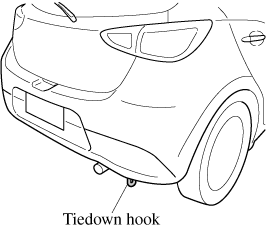

Tiedown Hook-Rear
The hook positioned under the rear bumper on the right side is for tying down the vehicle during transport, and it cannot be used for towing other vehicles.
It can be used as a towing hook only when the vehicle must be towed by another vehicle in an emergency case such as when the vehicle is stuck in snow, however, it may damage the bumper.

When using the hook in such emergency cases, observe the following so as not to damage the tiedown hook or the vehicle body.
-
The vehicle must be pulled straight to the rear so that no load is applied to the vehicle in the lateral direction.
-
The bumper may be damaged if the tie down hook is used as a towing hook.
-
When using a metal chain or wire lead, wrap a cloth around the attachment area. If the metal chain or wire lead contacts the bumper directly, the bumper could be scratched or damaged.




